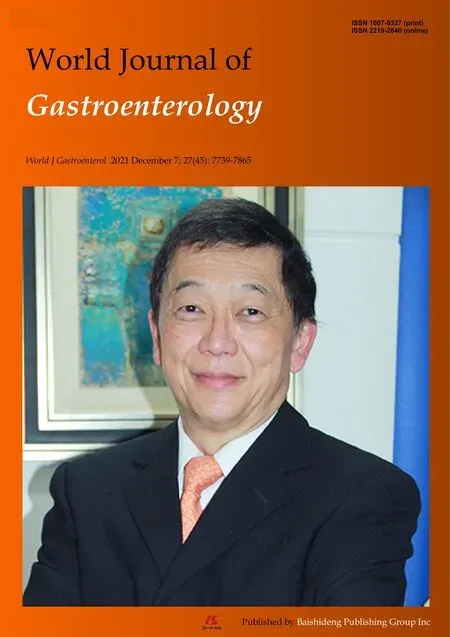SARS-CoV-2 infection in people with pre-existing liver disease: Further research is warranted
Henu Kumar Verma,LVKS Bhaskar
Abstract Patients with severe liver disease who have been infected with severe acute respiratory syndrome coronavirus-2 (coronavirus disease 2019 ) frequently develop acute respiratory distress syndrome and multiple organ failure, with a high mortality rate, as a result of the hyper-proinflammatory state known as the cytokine storm. Clinicians must recognize cytokine storms earlier to avoid intensive care admission and multi-organ damage, a critical life-threatening condition with prognostic and therapeutic implications
Key Words: Cytokine storm; Liver disease; Angiotensin-converting enzyme 2 ; Therapeutics; Inflammatory markers
TO THE EDITOR
Recently we have seen a paper entitled “Impact of cytokine storm and systemic inflammation on liver impairment patients infected by SARS-CoV-2 : Prospective therapeutic challenges” contributed by Aliet al[1 ] in your well-regarded journal “World J Gastroenterology”[1 ]. Regarding this paper, we would like to draw your attention to several valuable and interesting aspects. The current scenario is that the second wave of the severe acute respiratory syndrome coronavirus-2 (SARS-CoV-2 )[coronavirus disease 2019 (COVID-19 )] pandemic is much more aggressive, with many more cases reported in various countries. As of April 2021 , nearly 2 .5 million deaths worldwide have been attributed to COVID-19 . Based on the geographical distribution of the COVID-19 pandemic, it was found that in areas with a higher frequency, such as China, the rate of SARS-CoV-2 infected patients with liver impairment is also higher[2 ]. Most hospitalized COVID-19 patients have elevated liver biomarkers, primarily aminotransferase and bilirubin, which cause multi-organ failure[3 ,4 ]. This review paper by Aliet al[1 ] shows great public health interest. In their article, the authors elegantly described the impact of SARS-CoV-2 on hepatic impairment conditions.Besides, they focused on several current studies that indicated the role of the hyperinflammatory state that is known as “cytokine storm” concerning the angiotensinconverting enzyme 2 (ACE2 ) receptor as the main factor for the high rate of SARSCoV-2 spreading and mortality and its putative therapies[5 ].
The SARS-CoV-2 directly enters the host cell through surface receptors and binds to ACE2 [6 ]. ACE2 expression has been reported in different normal human organs,including the liver, where its expression is significantly low compared to the duodenum, kidney, and small intestine[7 ]. Accumulating evidence indicated the hepatic sharing of ACE2 after virus entry into the host cell. The underlying mechanisms of liver injury in COVID-19 patients are currently indistinguishable.However, human liver single-cell RNA-seq data indicated the co-expression of ACE2 and transmembrane serine protease 2 in liver progenitor cells, suggesting that the liver is the target of coronavirus disease[8 ].
Further, there is a 59 .7 % increase in ACE2 expression in cholangiocytes compared to 2 .6 % in hepatocytes, indicating that SARS-CoV-2 may directly bind to the ACE2 receptor, and the liver may be a good host for SARS-CoV-2 [9 ,10 ]. Histological analysis of liver biopsies of COVID-19 patients revealed moderate microvascular steatosis, mild lobular, portal activity, and T cell overexpression, showing that the liver injury could have been caused by either SARS-CoV-2 infection or treatment[3 ,11 ]. A hospital-based study in China revealed elevated levels of proinflammatory cytokines, chemokines,and growth factors in COVID-19 patients compared to healthy adults[12 ,13 ]. Further,the patients with severe COVID-19 show hepatic dysfunction or liver disorders,including chronic liver disease, hepatitis viruses (types B, C, D, and E), hepatotropic virus infection, non-alcoholic fatty liver disease (NAFLD), and non-alcoholic steatohepatitis with elevated platelet, neutrophil, and lymphocyte counts, resulting in the worst outcomes from acute respiratory distress syndrome[14 ,15 ].
There is no consensus among researchers regarding liver damage in COVID-19 patients; some studies proposed the immediate cytopathic effect of the virus on hepatocytes or the biliary epitheliumviaACE receptors[16 ,17 ]. Others postulated inflammatory and immune-mediated liver failure in patients with multiple organ damage[18 ]. However, hepatic inflammation involving cytokine activation was welldocumented. A case study of COVID-19 patients demonstrated that the C-reactive protein (CRP) of 20 mg/L and a lymphocyte count of 1 .1109 /L were independent risk factors for liver injury[19 ]. Kupffer cell activation is indeed a common finding in the liver of SARS-CoV-2 infected patients. Further, the altered macrophage polarization in SARS-CoV-2 -infected patients with NAFLD suggests that SARS-CoV-2 has mechanisms to divert macrophage polarization in their preferred direction and increase the synthesis of inflammatory cytokines[18 ].
Regardless of the precise definition, the combinations of clinical manifestation and inflammatory markers (such as elevated plasma levels of CRP, lactate dehydrogenase,interleukin (IL)-6 , IL-1 , tumour necrosis factor-alpha (TNF)-α, and ferritin) could be used to define the “cytokine storm syndrome” in COVID-19 patients[20 -22 ]. Besides this, treatment with anti-IL-6 receptor monoclonal antibodies (sarilumab and tocilizumab), anti-IL-6 monoclonal antibodies (siltuximab), IL-1 inhibitors (Anakinra,Rilonacept, and Canakinumab), and TNF-α inhibitors (adalimumab, etanercept, and infliximab) showed promising results against SARS-CoV-2 -induced cytokine storm[23 -25 ]. In addition, corticosteroids that are known to alter the nuclear factor kappa B pathway central to the cytokine storm were used to manage the severe SARS and Middle East respiratory syndrome patients[26 ]. As a cytokine storm is a critical lifethreatening condition and has prognostic and therapeutic implications, the clinicians must recognize cytokine storms earlier to avoid intensive care admission and multiorgan damage.
 World Journal of Gastroenterology2021年45期
World Journal of Gastroenterology2021年45期
- World Journal of Gastroenterology的其它文章
- Diagnostic biomarkers for pancreatic cancer: An update
- Therapeutic potentials of fasudil in liver fibrosis
- Clinical presentation of gastric Burkitt lymphoma presenting with paraplegia and acute pancreatitis: A case report
- In-hospital mortality of hepatorenal syndrome in the United States: Nationwide inpatient sample
- Multimodality management of gallbladder cancer can lead to a better outcome: Experience from a tertiary care oncology centre in North India
- MicroRNAs expression influence in ulcerative colitis and Crohn's disease: A pilot study for the identification of diagnostic biomarkers
